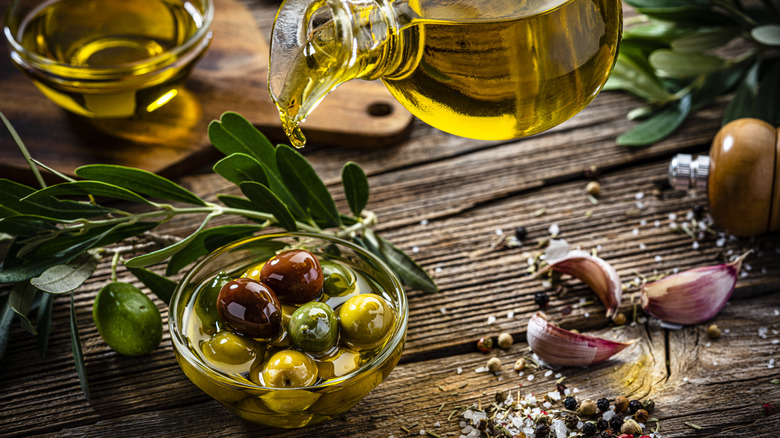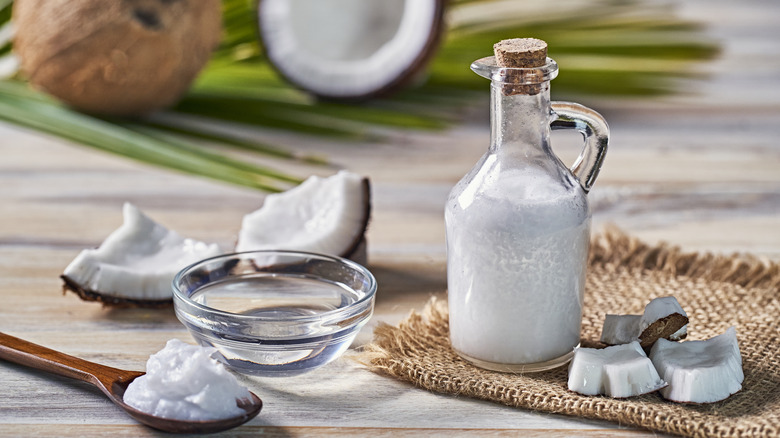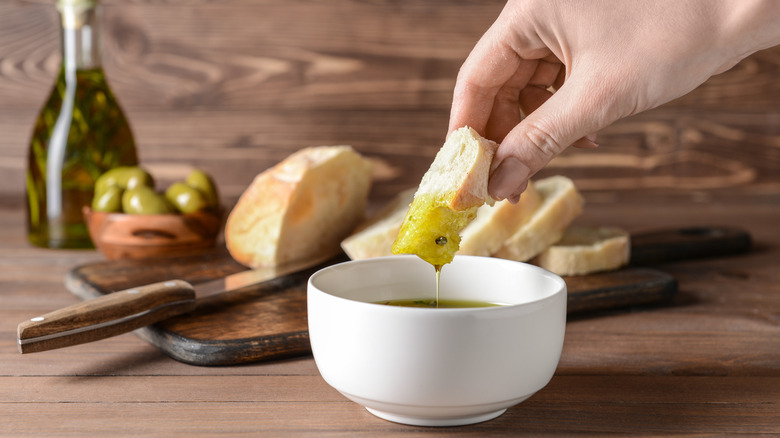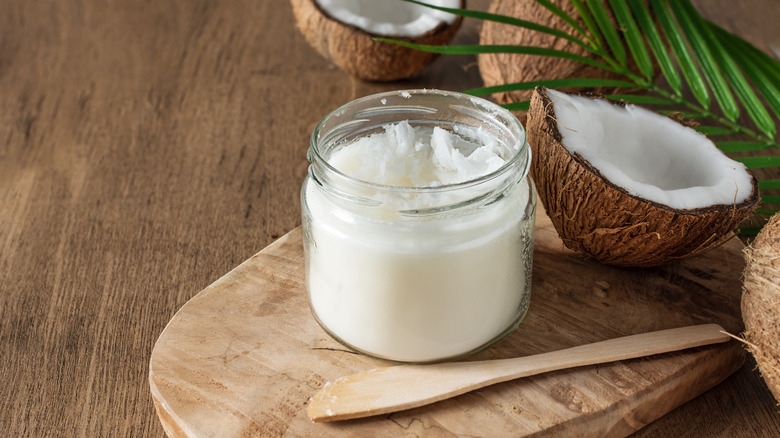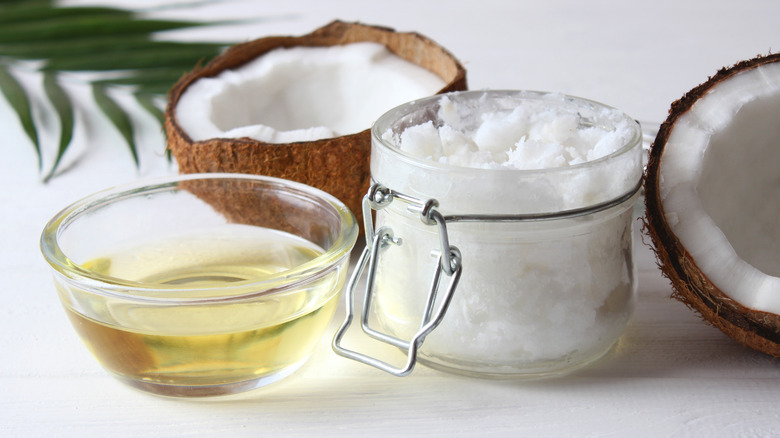Olive Oil Vs Coconut Oil: Everything You Need To Know
The debate between olive oil and coconut oil has sparked many discussions. These two kitchen essentials have found their way into countless recipes and even beauty regimens. So, what sets these oils apart, and how do they complement our lifestyle choices?
When it comes to heart-healthy oils, olive oil has long reigned supreme. With its origins deeply rooted in the Mediterranean, this elixir is celebrated not only for its robust flavor but also for its plethora of possible health benefits. From the fruity nuances of extra virgin to the versatility of regular olive oil, it's a staple that transcends cuisines. But then enters coconut oil, which has gained more global popularity in recent years. Now, you might be wondering how they compare and which to use.
Our exploration into the olive oil vs. coconut oil saga aims to demystify these kitchen companions. We'll delve into their distinct flavor profiles, nutritional merits, and practical considerations for cooking and beyond. Are you Team Olive or Team Coconut, or perhaps you're an advocate for keeping both in your culinary arsenal? Understanding the nuances of olive oil and coconut oil is key to making informed choices in your kitchen, so join us as we unlock the secrets behind these celebrated ingredients.
Grab your apron, and let's explore the unique characteristics that make olive oil and coconut oil indispensable in their own right.
What is olive oil and how is it made?
Few ingredients boast the versatility and potential health benefits quite like olive oil. But what exactly is olive oil, and how does this elixir make its way from the groves to our kitchens? Well, as the name suggests, olive oil is made from olives. This liquid is the result of pressing olives, the small, mighty fruits that thrive in the sun-drenched landscapes of the Mediterranean basin. The extraction process involves crushing the olives and extracting the oil through pressing or centrifugation. This careful method ensures the oil retains its distinct flavors and nutritional properties.
Enter the realm of olive oil, and you'll encounter a spectrum of choices, with regular olive oil and extra-virgin olive oil leading the way. Regular olive oil, often labeled simply as "olive oil" or "pure olive oil," undergoes a refining process and is sometimes blended with a percentage of extra-virgin olive oil. This results in a milder flavor, making it a versatile choice for cooking. On the other hand, extra-virgin olive oil, the crème de la crème, is the purest and highest quality. Extracted solely through mechanical means without any chemical processes, it preserves the olives' true essence, boasting a robust flavor profile. It's more often used for drizzling and finishing dishes than for cooking.
What is coconut oil and how is it made?
Derived from coconut kernels, coconut oil has transcended its origins to become a staple in kitchens, beauty routines, and wellness practices worldwide. The process of extracting it involves two main methods: wet processing and dry processing. Wet processing involves extracting the oil from coconut milk, while dry processing extracts oil from the dried flesh.
There are two main types of coconut oil: refined and unrefined. Refined coconut oil undergoes processes like bleaching and deodorizing to remove impurities, resulting in a neutral flavor and a higher smoke point. This makes it a versatile option for a range of cooking applications. On the flip side, unrefined coconut oil, often labeled as virgin or pure, maintains its natural coconut flavor and aroma. Extracted through a process that preserves the native essence of the coconut, unrefined coconut oil is ideal for those seeking a more robust scent and flavor. Once you understand the nuances between refined and unrefined coconut oil, it's easier to pick the one that's right for you.
What do they taste like?
You might be wondering what olive oil tastes like and how its flavor profile differs between regular and extra-virgin varieties. On the first taste of extra-virgin olive oil, you're greeted with a burst of freshness. The flavor is robust with prominent fruity notes. You may detect hints of green herbs, a peppery kick at the back of your throat, and perhaps a touch of bitterness. It has a complexity reflecting the nuances of the olives from which it's derived.
On the other hand, regular olive oil, while retaining some of the characteristic olive flavors, tends to be milder. The refining processes it undergoes contribute to a more neutral taste, making it a versatile choice for those who prefer a subtler impact on their dishes.
The two main varieties of coconut oil' – unrefined and refined — also have differing flavor profiles. Unrefined coconut oil — also known as virgin or extra-virgin coconut oil but with no differences — has a rich, pronounced coconut taste: sweet, nutty, and fragrant. It adds a slight coconut flavor to dishes.
As mentioned earlier, refined coconut oil undergoes processes like bleaching and deodorizing, so it results in a milder, neutral taste. This makes refined coconut oil versatile for cooking where you don't want to detect a coconut flavor. Whether you're aiming for a bold tropical kick or a subdued undertone, the choice between unrefined and refined coconut oil lets you tailor your culinary creations to your taste preferences.
What do coconut oil and olive oil look like?
Olive oil presents itself as liquid gold with a hint of green. It pours with a luscious, viscous consistency, catching the light with a subtle gleam. The color palette ranges from pale gold to deep green, a spectrum influenced by the types of olives used and the time of harvest. Some unripe varieties of the fruit have a green hue, but they might end up being processed with other types of olives ranging in ripeness and color. The beauty of olive oil lies not only in its taste but also in the visual allure it brings to salads, dishes, and drizzled presentations.
Coconut oil is solid at room temperature, resembling a creamy, ivory-hued concoction within its container. The texture is buttery and can have lumps. Its appearance adapts, becoming liquid when temperatures rise. When it's in its liquid form, it may be clear or slightly off-white, depending on whether it's refined or unrefined.
What do they smell like?
Now that you know a little bit more about olive oil and coconut oil, you might ask how they compare in terms of fragrance. Both have distinct aromas, and their scents vary depending on the type. Regular olive oil smells quite different from extra-virgin olive oil, and there are obvious differences between refined and unrefined coconut oil that your nostrils can detect.
Olive oil has a distinct aroma characterized by a blend of fruity notes, particularly in extra-virgin varieties. Extra-virgin olive oil carries a robust fragrance with hints of green herbs and pepper. Regular olive oil has a milder scent but still has a slight olive-like aroma.
Unrefined coconut oil, often labeled as virgin or extra-virgin, carries a rich, pronounced coconut aroma — a sweet and nutty scent. On the flip side, refined coconut oil offers a more neutral fragrance. The refined version basically has no smell at all. This is bad news if you were expecting something coconutty but good news if you want a versatile oil to use in a range of dishes.
How do their nutritional profiles compare?
The battle between coconut and olive oil wouldn't be complete without exploring how they compare in terms of nutrition. Let's unravel the nutritional profiles of these kitchen staples and shed light on how they stack up against each other.
Per Harvard Health, coconut oil contains over 80% saturated fats — the majority being lauric acid, which may contribute to raising LDL ("bad") cholesterol. While coconut oil's impact on heart health is a subject of ongoing research, the Mayo Clinic notes that large-scale human research has yet to verify the oil's possible beneficial effect. According to Healthline, coconut oil harbors medium-chain triglycerides, which are embraced for their potential metabolism-boosting properties.
On the other hand, olive oil is hailed as a cornerstone of the heart-healthy Mediterranean diet and boasts a different nutritional composition. It is rich in monounsaturated fats, particularly oleic acid, which is associated with numerous health benefits, including cardiovascular health, according to Everyday Health. It also notes that olive oil is a probable source of antioxidants, such as vitamin E and polyphenols, warding off oxidative stress, but overconsumption may lead to weight gain.
The types of fats each oil contains differ significantly. Coconut oil's saturated fat content has prompted debates about its impact on heart health, whereas the monounsaturated fats in olive oil are celebrated for their potential positive effects. This doesn't mean you should avoid coconut oil but perhaps consume it in moderation.
Do coconut and olive oil have different smoke points?
The smoke point of an oil is the temperature at which it starts to break down and emit smoke. Beyond this threshold, the oil undergoes chemical changes, producing an acrid taste and releasing potentially harmful compounds. Knowing the smoke point is important when deciding which recipes to use which type of oil in.
Extra-virgin olive oil, celebrated for its robust flavor and probable health benefits, has a lower smoke point compared to its refined counterpart. The smoke point of extra-virgin olive oil is roughly 350 F. While suitable for cooking using low to medium heat, care should be taken to avoid overheating. Regular olive oil has a higher smoke point — 465 to 470 F — so it's suitable for cooking at higher temperatures.
Like extra-virgin olive oil, unrefined coconut oil has a relatively low smoke point of 350 F, so its cooking uses are more limited. Refined coconut oil can reach higher temperatures, up to approximately 400 F, so it's better suited to roasting and pan-frying.
What are their uses in cooking?
Olive oil is a versatile choice in the kitchen. Extra-virgin olive oil, with its robust flavor and distinct aroma, is often the star of salad dressings and drizzles, adding a depth that elevates greens and vegetables. Its unrefined nature makes it a preferred choice for dipping crusty bread. You can also use it for cooking at a low heat.
Regular olive oil has a milder taste that's great for everyday cooking. Its higher smoke point allows it to shine in sautés, roasts, and other medium-heat applications, seamlessly blending with a wide range of dishes.
Unrefined or virgin coconut oil has a rich coconut aroma and flavor, so the ingredient is prominent in any dish. It can add depth to Indian, Thai, and other Southeast Asian curries. Refined coconut oil has a neutral scent and flavor, which means it has a wider range of uses for general cooking. It's ideal for sautéing, stir-frying, and deep-frying without overpowering the dish with a coconut taste.
So, whether you opt for olive or coconut oil, there are big differences between refined and unrefined or extra-virgin varieties. This means you need to be mindful of the type of oil you choose depending on how you want to use it.
How does olive oil compare to coconut oil in baking?
Thanks to its strong flavor and aroma, unrefined coconut oil will come through in baked goods. Its solid consistency at room temperature makes it a star in creating moist and flavorful pastries. From cookies and cakes to muffins and granola bars, coconut oil adds a subtle sweetness and a hint of the fruit. You can also use the unrefined version in baked treats when you don't want a coconut flavor. Its consistency makes it great for creating flaky pie crusts and crumbly pastries, and it's easy to substitute coconut oil for other fats. Use it in solid or liquid form as a 1:1 substitute for butter or other oils.
Olive oil is also a great choice for baking. Its liquid consistency means you can easily switch it out like-for-like in recipes that use vegetable oil or other cooking oils. Refined olive oil might impart a slight olive flavor but can bring a pleasant richness to baked goods. While extra-virgin olive oil isn't used as often in sweet recipes, lemon olive oil cakes or chocolate cakes often call for it to induce an interesting fruity richness. The subtle bitterness and peppery undertones of extra-virgin olive oil are perhaps more common in savory baked goods, making it a favorite in Mediterranean-inspired pastries and bread.
How do you store coconut oil and olive oil?
Olive oil should avoid its three adversaries: light, heat, and oxygen. As such, it thrives in a cool, dark haven. A pantry away from the stove and sunlight is its sanctuary, housed in a darkly tinted glass or opaque bottle to ward off light-induced degradation. To keep your olive oil fresher for even longer, you can buy an airtight, opaque container made out of ceramic, glass, or stainless steel that would keep out oxygen. The ideal storing temperature is 57 F, but an average room temperature of around 70 F is fine, too.
Keep coconut oil in optimal condition by storing it in a cool, dark place, away from direct sunlight. Use a sealed container to prevent exposure to air, ensuring the oil's purity and freshness. You can keep it in the fridge, as making it less prone to oxidation may help it last more, but seal it properly. Though, room temperature will do if you opt not to refrigerate it. Since you might be digging it out of the container rather than pouring it, always use a clean utensil to keep bacteria at bay.
All in all, you can store coconut and olive oil in fairly similar ways. Avoid excessive light, heat, and oxygen to last longer.
Which oil lasts longer?
The shelf life of olive oil depends on various factors. Regular olive oil typically retains its quality for around 18 to 24 months, while the extra-virgin variant spans a couple of months less. It will last longer if you store it correctly rather than exposing it to too much heat, light, or oxygen. Signs of aging or rancidity in olive oil are crucial to detect. If the oil develops an off odor akin to mustiness or a damp basement, it's likely past its prime. Additionally, a sour or vinegary taste indicates spoilage. Observe color changes, as an olive oil turning darker may signal deterioration.
Unlike olive oil, the unrefined version of coconut oil lasts longer than the refined one. Unrefined coconut oil can endure up to three years, while the refined counterpart typically maintains its quality for about 18 months. You should know what to look for in case your coconut oil goes bad. If the oil emits a sour or off-putting odor, it may have turned. A shift in appearance, particularly a yellow hue, chunkiness in the texture, and moldy spots, indicates degradation. Changes in taste, like a sour or unpleasant flavor, signify the need for replacement.
Is coconut oil or olive oil more expensive?
Price is often an important factor in purchases, and that might be the same when choosing between coconut and olive oil. Though the notable surge in the prices of olive oil in recent years may prompt a discerning eye toward alternatives like coconut oil, the two oils span much of the same price bracket.
Coconut oil prices vary depending on a range of factors, but the biggest difference is between refined and unrefined versions. Looking at grocery store prices, unrefined coconut oil typically costs between 40 and 75 cents per fluid ounce. Refined coconut oil is cheaper, priced at roughly 20 to 40 cents per fluid ounce.
Like coconut oil, olive oil prices vary depending on the type. Extra-virgin olive oil is the pricier option, costing between 30 and 85 cents per fluid ounce. Regular or light olive oil costs around 25 to 75 cents per fluid ounce.
Ultimately, price is unlikely to be too much of a deciding factor in which one you buy since their prices are relatively similar. Rather than focusing on cost, it's best to pick between olive oil and coconut oil based on their other properties.
Do they have any uses outside of cooking?
Coconut oil is commonly used for a range of haircare and skincare purposes, namely for its possible moisturizing benefits. For hair, it supposedly provides moisture and imparts a natural shine. Used sparingly, it may work as a leave-in conditioner, taming frizz and encouraging a sleek, shiny finish. You can also use it as an intensive conditioner or hair mask when your locks need a bit more attention.
Its potential hydrating powers are also useful in skincare, making it a perfect moisturizer, sinking into the skin to nourish it. If you have patches of dry skin on your body, coconut oil might be the answer. You can also incorporate it into many homemade skincare products, such as lip scrubs or face masks. Plus, it's a gentle way to remove eye makeup.
Olive oil isn't as commonly used in haircare or skincare as coconut oil, but it still has its uses. Craft a hair treatment with it, as the olive oil's rich composition can possibly deliver deep nourishment, enhancing hair strength and imparting a glossy sheen. It may act as a reparative elixir, addressing dryness and promoting overall hair health.
For skincare, olive oil can likely serve as a luxurious moisturizer to combat dryness. Packed with antioxidants, it might provide a shield against environmental stressors, contributing to a supple and radiant complexion. Olive oil's versatility extends to potentially soothing rough patches, offering a natural remedy for dry skin.

